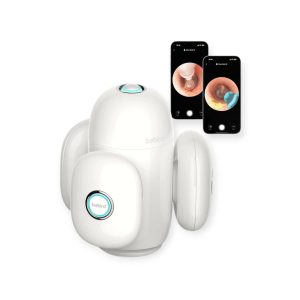With the innovative Bebird otoscope, you can now take a look inside your ear yourself. This handy camera allows you to safely and responsibly inspect your ear canal and eardrum. But when you look inside your ear, you may wonder: what am I actually looking at? In this blog, we explain what a healthy ear canal and a normal eardrum look like and how to recognize signs of an ear infection, such as otitis externa (inflammation of the ear canal) or otitis media (inflammation of the middle ear).
What Do You See in a Healthy Hearing?
When you look inside your ear with the Bebird camera, the first thing you will see is the ear canal. A healthy ear canal has certain characteristics:
- The Walls of the Ear Canal
The ear canal is usually a pale pink color and is slightly shiny due to the presence of a small layer of earwax. The walls are usually smooth, with no bumps or swellings. It is important to remember that the ear canal is a sensitive area, so be careful and avoid unnecessary movements so as not to cause irritation or damage. - Earwax in the Ear Canal
Earwax, also called cerumen, is a natural substance that protects your ear canal from dirt and bacteria. It usually has a light yellow to orange color, but the color can vary depending on the amount and type of earwax you produce. In small amounts, earwax is normal and healthy. - When is Earwax a Problem?
Earwax is only a problem when it is present in large quantities and blocks the ear canal. This can lead to hearing problems and a blocked feeling. If you notice with the Bebird camera that there is a lot of earwax present and it is blocking the passageway, you can consider gently removing it. Important: Never push the earwax deeper into the ear with the Bebird camera, as this will only make the problem worse and increase the risk of ear infections.
The Eardrum and What You Need to Know
At the back of the ear canal is the eardrum. This thin, flexible membrane is a crucial part of our hearing system because it collects and transmits sound vibrations to the middle and inner ear. A healthy eardrum has specific characteristics by which you can tell it is in good condition:
- The Color and Transparency of the Eardrum
A normal, healthy eardrum is somewhat transparent and has a pearly gray or light pink color. The eardrum should be uniform in color, with no red or yellow discoloration. - The Position of the Bones
In a healthy ear, the ossicles (hammer, anvil and stirrup) are visible behind the eardrum. In particular, the stem of the hammer, a small bone, can often be seen as a thin line through the eardrum. The presence of these bones behind the eardrum is a good sign because it indicates a healthy structure in the middle ear.
What is an Otitis Externa and What Does It Look Like?
Otitis externa, is an inflammation of the ear canal. This inflammation can be caused by bacteria, fungi or irritation, such as from using cotton swabs or water entering the ear canal. An inflamed ear canal may look different from a healthy ear canal:
- Red and Swollen Ear Canal
In otitis externa, the ear canal is often red and swollen. Instead of a smooth, pale pink wall, you will notice that the walls of the ear canal are darker and thicker. Sometimes fluid or discharge is also visible. - Pain when Moving the Ear
Although you can’t see it directly with the Bebird camera, pain is an important symptom of otitis externa. Often, touching the outside of the ear or moving the ear is painful with inflammation of the ear canal. - Secretions or Earwax that Looks Unhealthy
In some cases, a yellowish, odorous discharge may come out of the ear canal. This can be a sign of a bacterial infection. If you use the Bebird camera to see discharge or earwax that looks different than normal, such as cloudy or with a strong odor, it may indicate an infection.
What is an Otitis Media and How to Recognize It?
Otitis media is an inflammation of the middle ear, the area directly behind the eardrum. This inflammation is common in children, but can also occur in adults. Because otitis media is behind the eardrum, you will see signs of this inflammation in the appearance of the eardrum:
- Red and Swollen Eardrum
In a middle ear infection, the eardrum may be red and thicker than normal. This is because the eardrum becomes inflamed in response to the infection in the middle ear. - Bulging of the Eardrum
In otitis media, the eardrum may be bulging outward due to the pressure of fluid accumulating in the middle ear. This is an important sign of middle ear infection and indicates pressure buildup irritating the eardrum. - Fluid or Pus Behind the Eardrum
If the inflammation is severe, fluid or even pus may accumulate behind the eardrum. This fluid is usually not immediately visible, but if the eardrum is very transparent, a cloudy haze or yellow discoloration may be visible. This indicates the presence of fluid and is a sign of an active infection.
The Importance of Safe Use of the Bebird Camera
The Bebird camera is a useful tool for inspecting your ear canal and eardrum yourself, but it is important to use it carefully. Here are some tips to make sure you use the Bebird safely:
- Do Not Push the Camera Too Far Into the Ear
The ear canal is sensitive and by pushing the camera deep into the ear, you risk damaging the eardrum. So always try to proceed with caution and do not push the Bebird camera too far into the ear canal. - Don’t Remove All Earwax
While it may be tempting to remove all of the earwax with the Bebird, this is not wise. Earwax has a protective function, and removing too much can leave the ear vulnerable to infection. - Consult a Doctor If in Doubt
If you see anything with the Bebird camera that does not appear normal, such as a red, bulging eardrum or discharge, contact a doctor or hearing care professional. Treating ear infections yourself can be risky, so leave it to a professional.
-
 Bebird H30S€164,99
Bebird H30S€164,99 -
 Bebird Note 5 Pro€119,99
Bebird Note 5 Pro€119,99 -
 Bebird R1€29,99
Bebird R1€29,99 -
 Bebird T15€43,99
Bebird T15€43,99
Conclusion
With the Bebird camera, you can easily take a look inside your ear canal and inspect the eardrum yourself. A healthy ear canal is pink and smooth, with a small amount of light-colored earwax, while a healthy eardrum is light gray and transparent. If you notice signs of inflammation, such as redness, swelling, discharge or a bulging eardrum, it may indicate an inflammation such as otitis externa or otitis media.
The Bebird is a valuable tool for visual inspection and gently removing excess wax, but remember that it is not intended to remove all wax or go deep into the ear. Always consult a professional when in doubt about the health of your ears.








